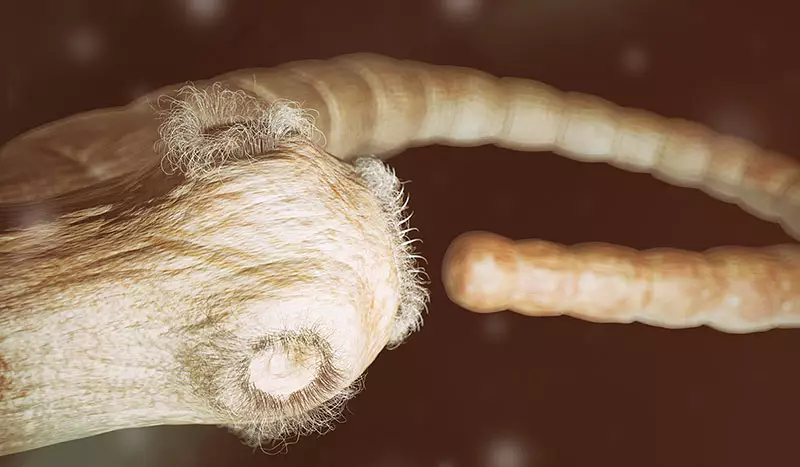Tapeworm in dogs and cats
What is tapeworm?
A tapeworm is a parasite that attaches itself to your dog’s or cat’s intestines using a system of suckers or muscular grooves. Tapeworms are long and flat with a body that consists of multiple segments, each with its own reproductive capabilities. Once in the animal’s intestine, they can reach four to six inches in length.

The worm grows new segments – up to ninety – as it feeds off your dog or cat and produces sacks filled with many eggs that can end up gathering around your pet’s anus area. Each segment is essentially an immature tapeworm, ready to separate and go on its merry way – it has its own reproductive organs and contains many hundreds of eggs. Because of the segmented nature of the tapeworm’s body, the head must be destroyed for the infestation to be eradicated.
 Tapeworms aren’t as dangerous for dogs and cats as other worms such as the round worm, the hookworm and whip worm. They are known as the smart parasite because they don’t cause a great deal of damage to their host.
Tapeworms aren’t as dangerous for dogs and cats as other worms such as the round worm, the hookworm and whip worm. They are known as the smart parasite because they don’t cause a great deal of damage to their host.
The type Dipylidium caninum is the most common tapeworm for both dogs and cats and is carried by fleas. Other types are the Taenia and Echinococcus species found in rodents, rabbits and even sheep.
It’s difficult for humans to become infected with Dipylidium caninum as an infected flea must be swallowed by the host. Some cases, however, have been known to occur in children.

Symptoms of tapeworm in dogs and cats
Tapeworms are largely the source of prolonged irritation in dogs and cats. Although they aren’t known for causing serious health problems in dogs and cats, it’s important to be aware of the symptoms and to take action if you notice them.
- Dragging the bottom along the ground. This is their attempt to address the irritation the tapeworm infestation is causing them. Cats can behave in a similar manner, however this behaviour is much more common in dogs.
- Biting of the rear end, seen in both dogs and cats.
- Degrees of weight loss can be experienced by both cats and dogs, if there are significant numbers of tapeworms in the digestive system.
- Sometimes a tapeworm will detach from the host’s intestines and move into the stomach. If this occurs, the dog or cat will vomit a long flat worm several centimetres in length.
- As the tape worm matures, segments carrying eggs will break off the end of the worm and may turn up in droppings or in the fur around the anus. These will look similar to small cream-coloured grains of rice.
Diagnosis of tapeworm in dogs and cats
While it’s important for owners to be aware of, and look out for, the symptoms at home, proper diagnosis and treatment require a visit to your local veterinarian. If you suspect that your dog or cat has a tapeworm infestation, it is very important to keep them away from children and other animals around the home. If your pet toilets in the backyard, clean up all excrement and dispose of it thoughtfully.
Vets will need to observe the cream-coloured tapeworm segments found in your pet’s droppings or around the anus area to make a definitive diagnosis of tapeworm. It won’t always be possible for the vet to see the segments because they aren’t excreted every bowel movement. If you do notice the symptoms described above and have seen the rice-like segments in your pet’s faeces, then collect a sample and take it to the vet with you. This will help them to make a better diagnosis.
In some cases your vet will take a smear sample and observe it under a microscope, in order to determine the type of worm infestation.

Treatment of tapeworm in dogs and cats
Luckily, once the diagnosis has been made, treatment is generally simple and straightforward. Modern deworming medications will completely remove tapeworm infestations with a simple tablet or injection and are largely free of side effects.
These medications dissolve the tapeworm in your pet’s digestive system, so you won’t be seeing anything passed through their faeces.
Because Dipylidium caninum is carried by fleas, the treatment of lice and fleas should also be carried out at the same time. This will help to prevent future infestations from occurring.
If the infestation is severe and persistent, your vet could prescribe a year-long program of on-going visits for treatment. This option is quite expensive but, when necessary, is the best solution for your pet.
Prevention of tapeworm in dogs and cats
The best treatment is prevention. There are a number of things you can do to prevent your pet from becoming infested with tapeworms.
- If your dog toilets outdoors in the backyard, make sure to clean it up at least once a week.
- If your dog socialises with other animals at the park or down the street, try to avoid wandering dogs or cats. If the other person’s dog shows any symptoms of tapeworm infestation, it’s time to say goodbye and move on.
- If you live in the country, try to keep your dog from coming into contact with dead rabbits or the like. All sorts of nasty things can be ingested or transmitted from carcasses and dogs seem to just love getting hold of them.
- Be sure to use the dewormer that your vet has prescribed properly. If it’s a recurring or persistent case, take your pet’s droppings in for a faecal examination regularly.

Commonly affected breeds
Tapeworms affect all breeds of dogs and cats as well as other animals like cattle, sheep, pigs and even human beings.
Interesting facts
- Tapeworms can lay thousands of eggs per day. Once you start to notice those worm segments around your pet, it’s time to visit the vet.
- Although tapeworms live in the digestive system of an animal, they don’t have a digestive system themselves—they simply absorb nutrients through the skin.
- You’ll never see a worm-like shape in your pet’s droppings unless the worm has fallen away from the wall of their intestines.
- Tapeworms need an intermediate host in order to infect your pet. Fleas are the intermediate hosts for Dipylidium caninum and mice and other small rodents are the hosts for Taenia taeniaeformis found in cats.
Bow Wow Meow Pet Insurance can help protect you and your pet should an unexpected trip to your vet occur.
- Find out more about our dog insurance options
- Find out more about our cat insurance options
- Get an instant online pet insurance quote
Bow Wow Meow is proud to have been awarded winner of Canstar’s ‘Most Satisfied Customers’ Award in the Pet Insurance category for both 2024 and 2025!
Bow Wow Meow is proud to have been chosen as Product Review’s Pet Insurance Award Winner every year from 2018 to 2025! This is based on 2,995 independent customer reviews (as at 21/01/2025), with an overall rating of 4.3*
Google Review rating = 4.5* (based on 968 reviews)
Trust Pilot rating = 4.6* (based on 531 reviews)
Bow Wow Meow is proud to have been chosen as Product Review’s Pet Insurance Award Winner every year from 2018 to 2025! This is based on 2,995 independent customer reviews (as at 21/01/2025), with an overall rating of 4.3*
Google Review rating = 4.5* (based on 968 reviews)
Trust Pilot rating = 4.6* (based on 531 reviews)
Bow Wow Meow has been chosen as a winner in the Finder Pet Insurance Awards 2024. Finder’s panel of experts analysed over 140 quotes to award our Ultimate Care Plan the winner of the “Pet Insurance – Value” category.










